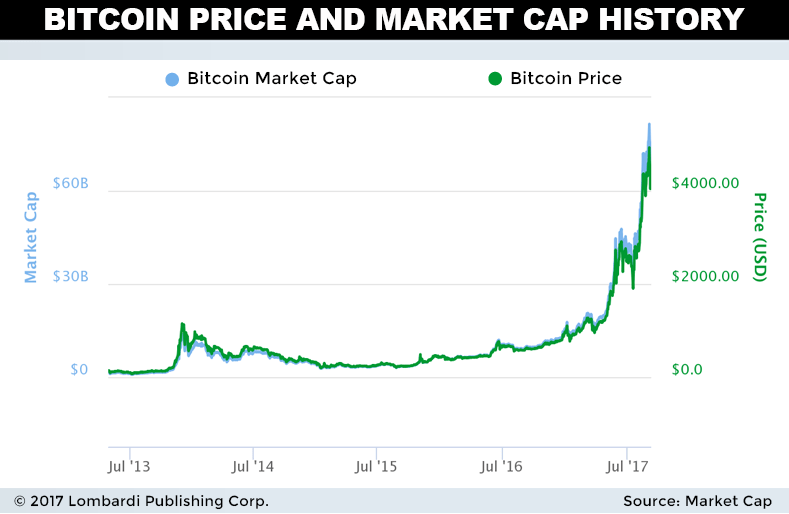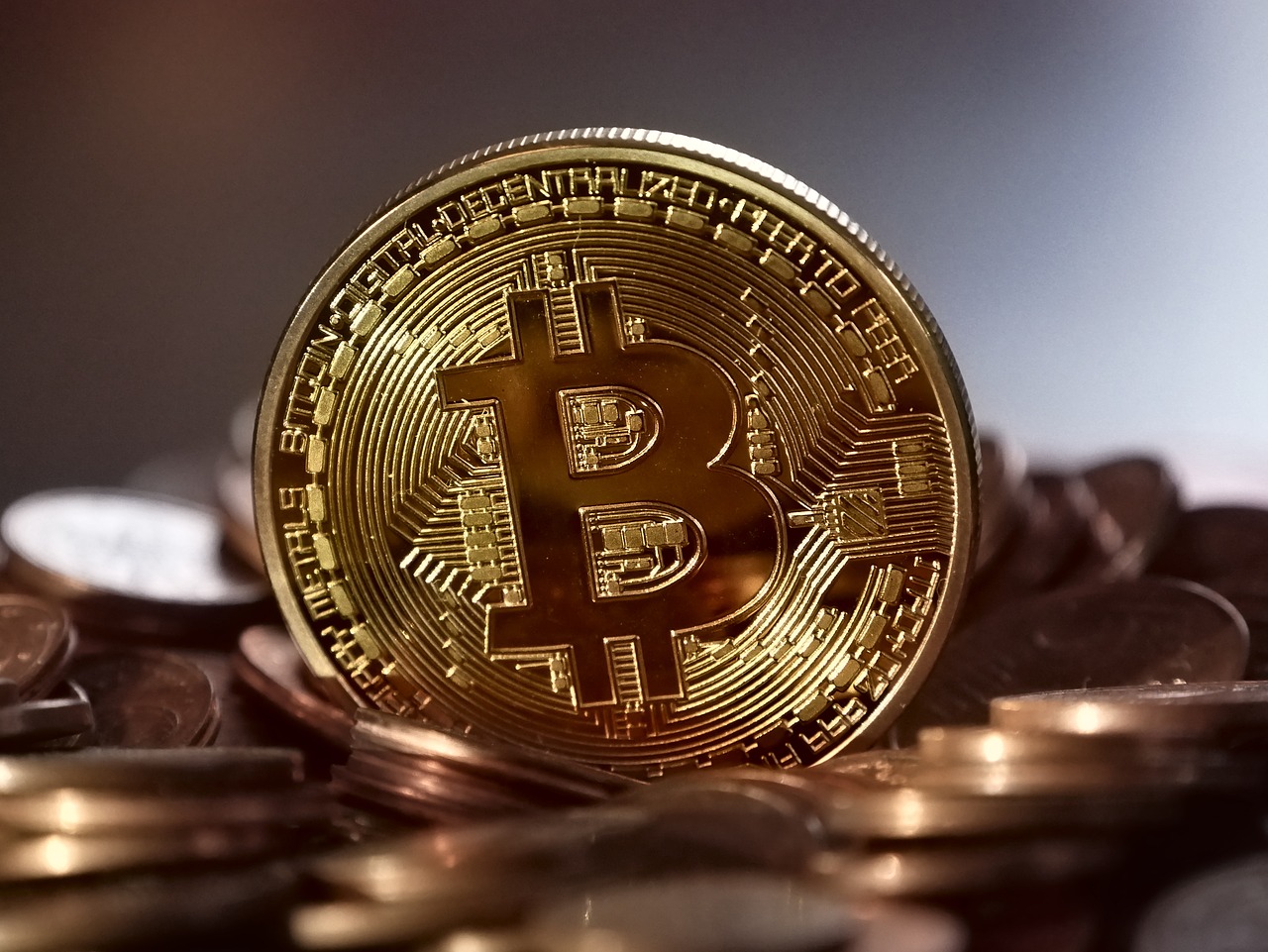Bitcoin has taken the world by storm. The digital crypto-currency recently saw trading levels hit $5,000 a coin, a record breaking milestone for the currency. It has indeed been quite a journey considering its first recorded price of $0.003, only seven years ago.
With a current market capital of $75 billion US Dollars, it has rose to the top of it’s game and has many believing it will transform our day-to-day lives, whilst others are suspicious and believe it is a disaster waiting to happen.
Background
In January 2009 Bitcoin went live and the world had its first decentralised form of digital currency. The idea of a currency operating without third-party intervention is potentially the key to its success.
Bitcoins themselves are scarce, as there will only ever be 21 million coins in circulation, and the current level is around 17 million. The only way to create new bitcoin is to ‘Mine’. This process involves solving complex mathematical algorithms with specific software. Once completed, these algorithms add transaction records to the public ledger of all user transactions which is accessible to the entire network.
This ledger is known as ‘Block-Chain’, and is said to completely revolutionise the way businesses interact.
IBM CEO and Member of the American Technology Council Ginni Rommety has said that “Block-Chain will do for trusted transactions what the internet did for communications”. (Business Insider UK).
Trading Record
To put Bitcoin’s journey into perspective, if you had bought 100 bitcoins in August of 2010, when 1B = $0.07, it would have cost you $7. If you kept those 100 Bitcoins, at the time of writing today (September, 2017) they would be worth $465,217.

Bitcoin’s Trading History Chart – Coingecko.com
Here are just some of the key milestones that have lead to it’s success;
- 9th February 2011 – Price hit 1B = $1.
- 15th March, 2013 – Cyprus Bail out. As part of the €10 Billion bail out offered by the EU and IMF, there would be a substantial levy on bank accounts over €100,000. This was an issue for wealthy Cypriots, but also for the many individuals worldwide who had used Cyprus as a tax haven due to the policies it had in action. In attempt to protect their capital, many investors turned to bitcoin, and it saw Bitcoin boom from levels around $80, to as high as $260. (CNNMoney)
- 18th November, 2013 – The U.S Senate held a hearing on Bitcoin, and the results were positive. The recognition of potential for Bitcoin by the Senate saw the price move from $685.75, to over the one thousand mark, at $1072.83 within ten days.
- 1st April, 2017 – Japan accepted Bitcoin as legal tender. This pushed the price of Bitcoin from $1085.03 to around $1215.69. It also fuelled the East Asian involvement in Bitcoin, a large contributor today.
- 1st August 2017 – Bitcoin fork introduced, and the code split into Bitcoin, and Bitcoin Cash. Prices for the digital currency had risen to $3383.79, and the digital currency wave was well under way.
-( 99 Bitcoins.com)
The last two developments of Bitcoin are arguably the most significant. With the Japanese acceptance of Bitcoin, the levels of investment from East Asia increased significantly. Due to concerns over Chinese growth-to-debt level and the consequential effects on the Yuan, Chinese investment in Bitcoin has reportedly grown to 85% of total Bitcoin transactions.
Secondly, the fork introduced enabled substantial growth for Bitcoin. A fork is essentially a protocol update, and there are two types of Forks – hard and soft. A Hard fork instructs all users of the network to update to the new protocol. Failure to do so means any future transactions will not be validated into the block-chain ledger. Whereas Soft Forks do not require all users to update, only the miners. However, all transactions will be verified into the Block-chain, whilst both channels operate.
The forked Bitcoin cash allows the processing of 8MB blocks, against the original Bitcoin’s limit of 1MB blocks.
On the 1MB data scale, the coding only allows the process of 7 transactions per second, which compared to larger networks of payment is not a lot at all. For example, according to Digital Transactions, Visa hit 56,000 transactions per second in 2014.
As Bitcoin gains more traction, the need for more processing space is attractive, and will only add more value to the block-chain network.
Not all Sunshine and Rainbows
The first major hit was the hacking of the popular Bitcoin trading exchange, Mt. Gox in June of 2011. A Hacker was able to gain user information from the Mt. Gox database, and began to sell large quantities of Bitcoin. This caused the price to plummet from around the $17-dollar mark, to as low as $0.01. Mt. Gox managed to reverse the transactions, but had to close trading for seven days to re-establish their security. (ZDnet)
Then, in February of 2012, Bitcoin exchange Tradehill severed all ties with Bitcoin. This had a direct effect on the market for Bitcoin, as Tradehill immediately sold all of it’s Bitcoin investments in order to refund their clients.
These moves came amongst concerns of the legality of Bitcoin, and also regulatory issues with the exchange of it. The result was a fall in the value of Bitcoin of -24% in the ten days following.
There were also the two rejections for ETF’s in the month of May, 2015 made by the United States Securities and Exchange Commission. The first application came from twins Cameron and Tyler Winklevoss, who were met with rejection due to an apparent “lack in regulation and surveillance sharing between exchanges” (CNBC, 2017).
According to Reuters, after the ETF denials the price of Bitcoin fell by up to -18%, but recovered amicably and managed to remain above $1,000 per coin.
Risks of Holding BTC
Yes, Bitcoin is now very attractive. Having broke the $5,000 a coin mark, global investors are clearly taking to the digital currency. Yet, as more invest and the price rises higher, there are specific risks outside of the normal investing risks that everyone should be aware of:
Regulatory Risks: Just as the price rose with the positive regulation of Bitcoin in Japan when they accepted it as legal tender, the price will dramatically fall if significant regulations arise that threaten the online currency.
As mentioned, China is home to the majority of Bitcoin activity. If regulations arise prohibiting private activity with Bitcoin – as they did for financial institutional activity in 2013 – the price of Bitcoin would crash horrifically.
Risks of Cyber-Attack: As explained, the hacking of popular Bitcoin exchanges and institutions that interact with Bitcoin have significant impact on the value of Bitcoin. If an attack were to happen again on a larger scale, the uncertainty that follows could be enough to crash the currency.
51% Attack: Currently, there are many thousands of different mining operations spread all over the globe. This way, the system remains fully decentralised. However, if one mining operation gains more than 50% of the block-chain network, then it is able to reverse transactions and therefore the entire network fails as there is no trust left within it.
Bitcoin’s Application to Trade Finance
The potential benefits of using Bitcoin for trade finance are not unaccompanied by potential downsides, however the benefits are believed to outweigh the downsides as we are seeing increased levels of block-chain platforms raised world-wide for financing trade.
Nasdaq recently announced its first ever shared transaction on the block-chain ledger, and there is also the R3 Consortium’s latest prototype application that’s purpose is to reduce inefficiencies in current trade finance by reducing the processing time of sight letters of credit.
The 11 banks that contributed includes the likes of HSBC, U.S Bank and Bangkok Bank, and realistically they have approached a valid issue.
Many areas of the process of trade finance can be outdated, and timely. With the block-chain application, the process of data transaction and validation is instant.
The Financial Times reported that the first trade finance transaction over the block-chain platform was carried out by Barclays and Israeli company Wave, when they guaranteed the exports of almost $100,000 worth of dairy products. The process usually takes around ten hours, and was fully completed with Block-chain in just under four.
No one is entirely sure where Bitcoin will go. Some believe its revolutionary, some believe its destined for failure and is just a bubble. Only time will truly tell, but you can be sure it will be a bumpy road.























